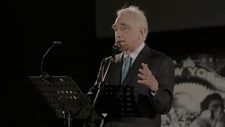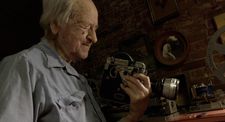Film, The Living Record Of Our Memory (a highlight of the 12th edition of DOC NYC) features insightful commentary from filmmakers Ken Loach, Jonas Mekas (Todd Haynes dedicated The Velvet Underground to Jonas), Kevin Brownlow, Fernando Trueba, Costa-Gavras (President, La Cinémathèque Française), Patricio Guzmán, Ahmad Kiarostami (producer for Abbas Kiarostami), Idrissa Ouédraogo, Martin Scorsese, Bill Morrison, Ridley Scott, Nicolas Rey, Wim Wenders (on music rights and restoration), and cinematographer Vittorio Storaro.
In the first instalment with Inés Toharia, we discussed an Orson Welles’ quote, Henri Langlois rescuing FW Murnau’s Faust, Duyu Dan’s Pan si dong (Journey To The West, 1927), the inspiration of Jonas Mekas, Pan Nalin’s Last Film Show (a highlight of the 20th edition of the Tribeca Film Festival), and Scorsese’s crucial role in preservation through the Film Foundation.
Film, the Living Record of Our Memory takes us around the globe from the National Library of Norway, where a print of Pan si dong was discovered, to the Sudan, India, Japan, France, the Philippines, Italy, Thailand, the BFI National Archive, Pixar, the African Film Heritage Project and beyond, into the world of those taking on the immense challenge of the urgent need for film preservation and restoration.
Costa-Gavras likens cinema to a rearview mirror and Bill Morisson calls the decomposition of film stock “an image for our own rotting memories.” There is a lot of fascinating history to discover that speaks of changes in awareness. Big Hollywood studios used to destroy their own films and melt them down for silver, as though another new Fred Astaire movie were always just around the corner for all eternity.
Nitrate film, so flammable that it continues to burn in water, makes, according to an archivist, the bottom of the Pacific the greatest film archive of them all. From the formation of the FIAF in 1938, which connected the Cinémathèque française in Paris, the Reichsfilmarchiv in Berlin, the British Film Institute, and the Museum of Modern Art Film Library in New York to all the various preservation efforts in the present - this is a treasure chest for anyone who cares about memory.
We learn that Martin Scorsese shot Raging Bull in black and white so that it wouldn’t turn magenta when the print aged, details on the history of hand tinting, and how dark Billy Wilder’s Sunset Boulevard really was supposed to be.
A particularly enchanting nugget recounts how the actual bell from the ship of explorer Captain Scott ended up on the soundtrack of the British Film Institute’s restoration of the 1924 documentary The Great White Silence, approximately a century into the future of his expedition to Antarctica, to go with the very first images of penguins captured on film.
From Spain, Inés Toharia joined me on Zoom for an in-depth conversation on Film, The Living Record Of Our Memory.
Anne-Katrin Titze: Let’s talk about your very big film! Jonas Mekas says at one point that cinema is like a big tree with many branches. Your film feels like a tree that grows branches into preservation and restoration. It feels as though the film grew with the people you were interviewing. Is this how the film evolved?
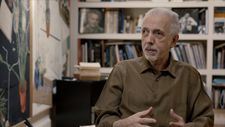 |
| Inés Toharia on Fernando Trueba’s Queen of Spain: “I told him, I’m so grateful because you put in so much detail to create everything! |
Inés Toharia: I think you’re right, yes. Perhaps Mekas inspired us, and we realised how preservation is a collaborative effort, just like filmmaking. We realised that all the archives are connected. Jonas explains it very well how we have this idea of fictional films, but there’s so many genres in filmmaking.
AKT: That is one of the branches where you bring up the home movies, and science films - all those people might not think about when thinking about preservation. The interconnectedness of the archives is very very interesting.
Starting with Langlois being responsible for us today to be able to see Faust, because he had a copy in Paris, while the German archives were destroyed. Also Pan si dong, Journey to the West! The fact that the first filmed version of the old Chinese legend was found in Norway! Were there surprises for you along the way? Probably lots!
IT: There were, there were! Sometimes you prepared everything so well and you were so surprised when other stories came up and they were fascinating. It’s all so rich and you can see how people who work in archives are very passionate about their work. It’s really contagious. I found out so many things researching and also talking to people.
AKT: So it’s also detective work? Detectives like to share what they are doing, too.
 |
| President, La Cinémathèque Française Costa-Gavras likens cinema to a rearview mirror |
IT: You’re right. They bring even further ideas and footage that they have found that could be connected to someone. You talk to someone from Taiwan, oh we have someone to connect you to, and it always grew.
AKT: It’s wonderful to see the joy in preserving the past. Fernando Trueba talks about preserving the past. He says “to know and to study it is the basis of life.” His films are filled with that notion. I love the clip you chose from The Queen of Spain.
IT: It’s true how we learn; I’m originally from Spain, but I have not lived in that era. I told him, I’m so grateful because you put in so much detail to create everything! Even the magazines and posters. The same thing with Martin Scorsese’s Hugo - the details of properly preserving are also for you to learn.
AKT: Totally. Trueba is wonderful at that. I talked with him twice, the last time in 2017 about this exact film. Did you talk to Scorsese? There’s no interview on camera.
IT: There’s no interview with him, but we saw him in Bologna. We didn’t speak for the film. We did speak with Margaret Bodde of the Film Foundation. We almost spoke to him, but he was working on The Irishman with Thelma Schoonmaker. We were hoping to catch up with them both, because they work together so closely and they are so crucial for Michael Powell’s work.
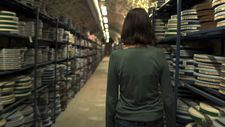 |
| Cinémathèque Française film vaults in Film, The Living Record Of Our Memory |
AKT: Oh yes!
IT: She married Michael Powell too and they preserved their work. It was also a great story I wanted to cover. Through Margaret we did cover what the Film Foundation means and Scorsese’s crucial role in preservation. I think Langlois and him are the two people - they’re very different, but they opened everyone to understand why.
Of course, Langlois, sometimes people are not so happy with him because he was a bit of a mess. But he’s crucial and I really love his work and what he has done. Scorsese has been really the one for the contemporary moment who opened us to what preservation is and how important it really is.
AKT: While you were talking, I imagined Langlois standing there with a big net and there is Scorsese in the future holding the other side, trying to catch all the films and to keep them alive. Another quote I loved - of course you couldn’t talk to Orson Welles because he’s dead - is his. Welles said: “Film has a personality. And that personality is self-destructive. The job of the archivist is to anticipate what the film may do and prevent it.” I think that’s my favourite quote in the film.
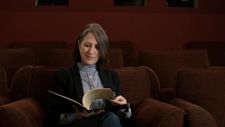 |
| The Film Foundation Executive Director Margaret Bodde |
IT: Archivists know about nitrate films. It’s a quote that some people in archives know, but it’s not really known by film historians. I’ve been approached by people who love Orson Welles and they were like wow, how did he know archives? Well, he was a person who really thought about those things and he appreciated the work of the archivists.
It’s wonderful to be able to say even back then filmmakers were very in-touch with the archives. It was a way to preserve it for the future. It’s a bit of an irony, because Orson Welles, some of his films are missing and he didn’t finish them. I guess perhaps he was waiting that someone would recover his work to finish it later in time. That’s something I kept thinking, what would Orson Welles say today? I would have loved to interview him.
AKT: Oh yes, I would have too. I think it is the head of the Cinémathèque française who quotes Langlois as saying about the lost Murnau films that we don’t deserve them yet.
IT: Yes, it’s Frédéric Bonnaud, the current director of the Cinémathèque française. He said that Langlois said that when Murnau’s lost films show up, it’s when humanity will deserve them, but perhaps we haven’t deserved them yet because they haven’t reappeared or resurfaced.
 |
| Tina Anckarman at work at the National Library of Norway |
AKT: We haven’t deserved them yet, if you look at the world, no.
IT: Not really yet!
AKT: By the way, did you see Pan Nalin’s Last Film Show?
IT: Oh yes, yes, I watched it recently. I loved it. The recycling into bracelets!
AKT: Exactly!
IT: Oh I love that film. I hope people see it, because it’s really wow. I didn’t expect that and the child actor [Bhavin Rabari who plays Samay], he’s amazing, too.
AKT: I spoke with Pan Nalin when the film was in Tribeca earlier this year and those bangles! The fact that films in India were turned into bracelets! I thought you would love it, too.
IT: I really did. I’m glad you watched it too. How the kid looks at this bracelet and I kept thinking what is he thinking?
AKT: Yes, which film made this bracelet? Kubrick? Hitchcock? Thank you so much for your insightful film! Have a good night and Happy Thanksgiving, although you are in Spain!
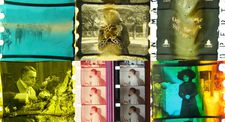 |
| Film deterioration samples in Film, The Living Record Of Our Memory |
IT: I love holidays! Very nice to talk to you!
Coming up - Inés Toharia on Wim Wenders, Lon Chaney’s The Unknown, the Mostly Lost Film Festival, Lotte Reiniger’s The Adventures Of Prince Achmed, Disney and Pixar preserving their films on film, Questlove’s Summer Of Soul (...Or, When The Revolution Could Not Be Televised), the USC Shoah Foundation, and a wide representation of film archives and locations around the world.
DOC NYC in-cinema screenings of Film, The Living Record Of Our Memory took place on Sunday, November 14 and Monday, November 15.
Film, The Living Record Of Our Memory is screening online through Sunday, November 28.
DOC NYC 2021 in cinemas (IFC Center - SVA Theatre - Cinépolis Chelsea) ran from November 10 through November 18. Select films are screening online in the US from November 19 through November 28.









